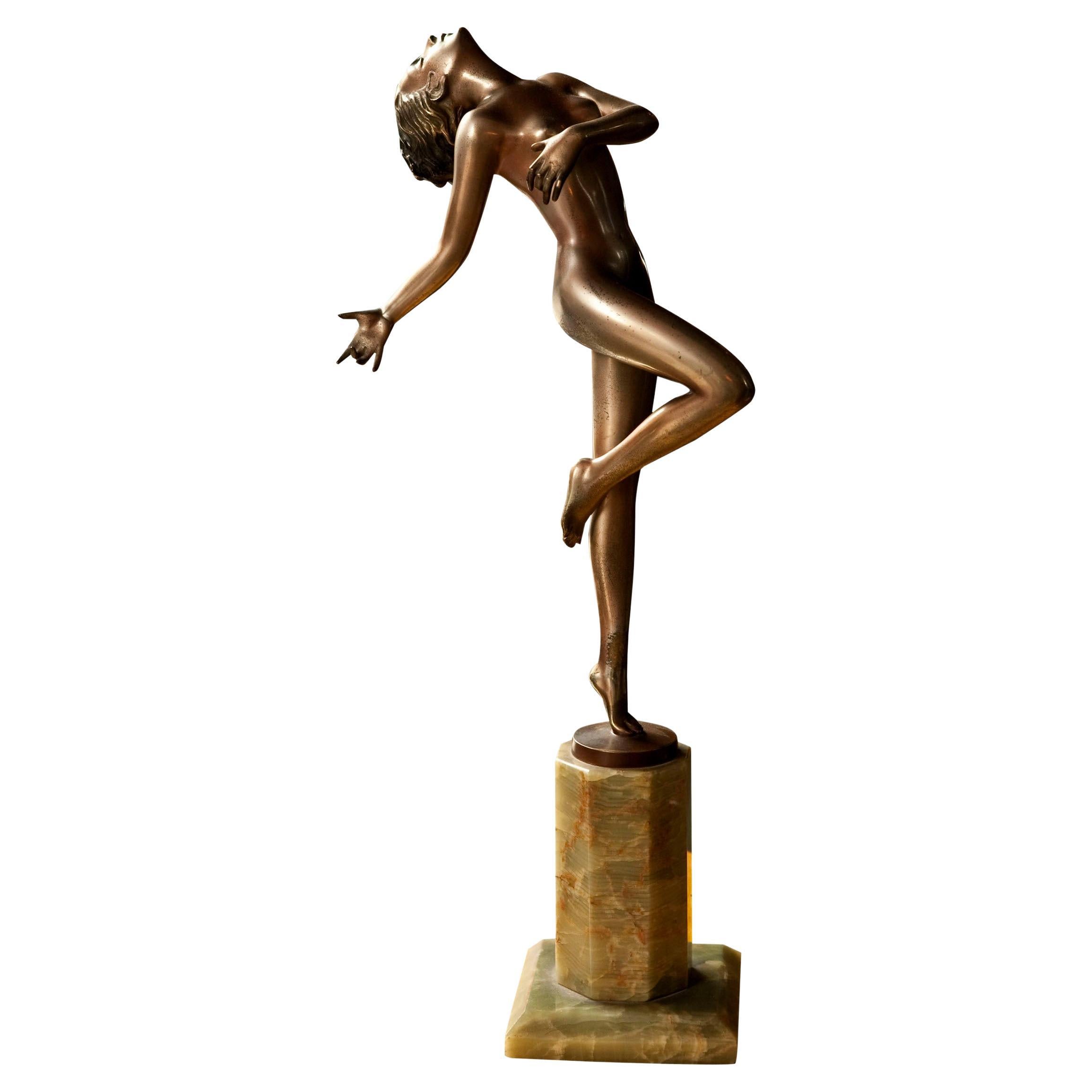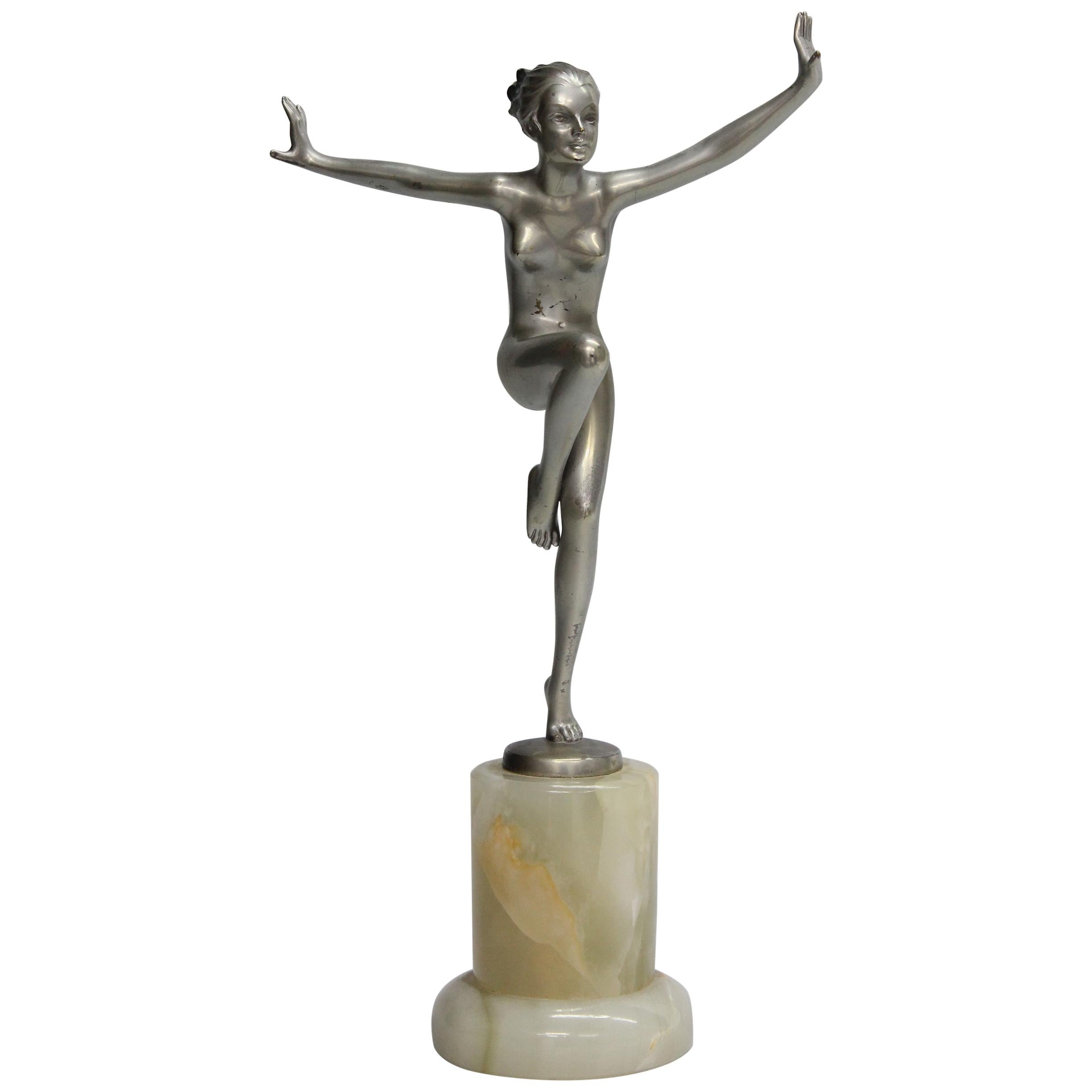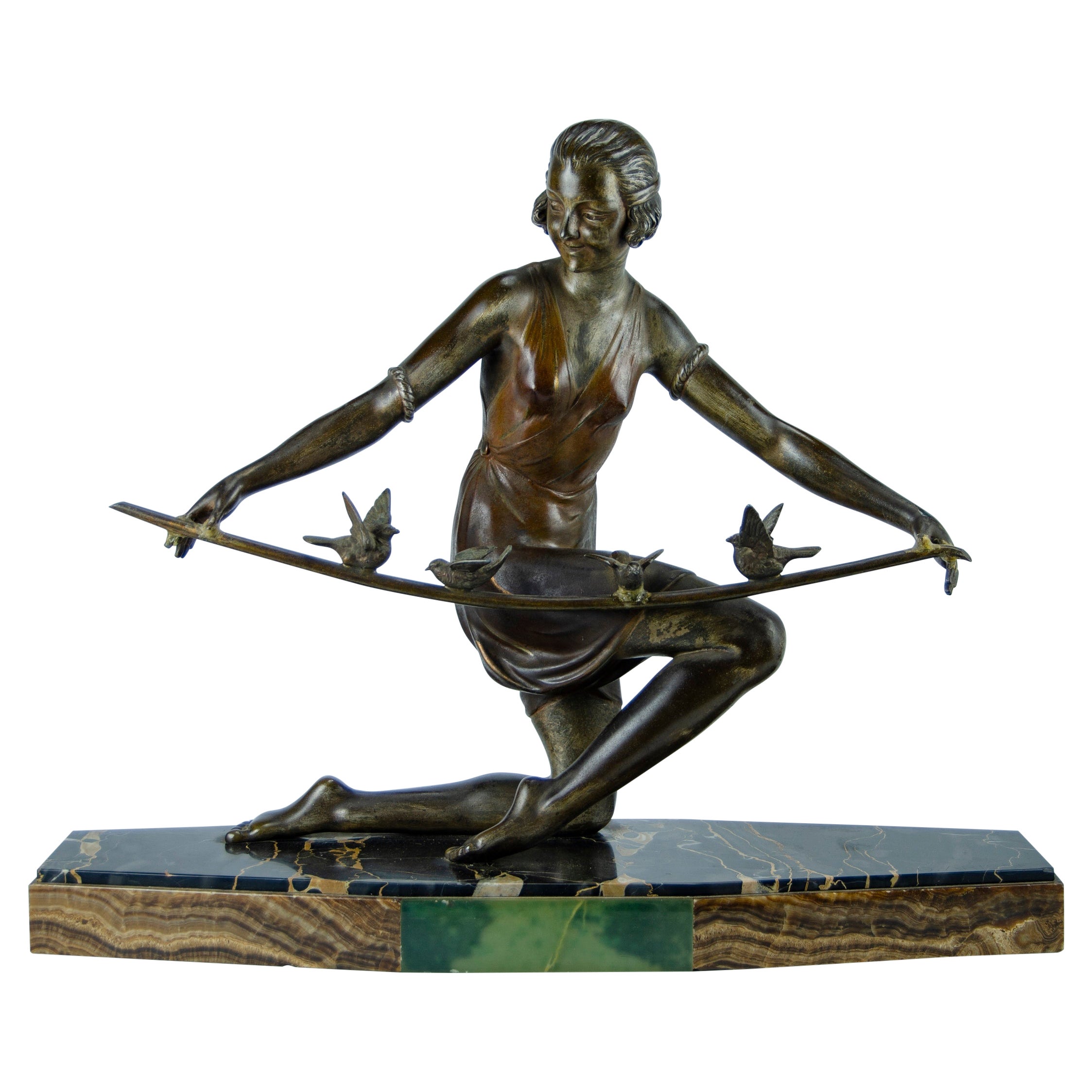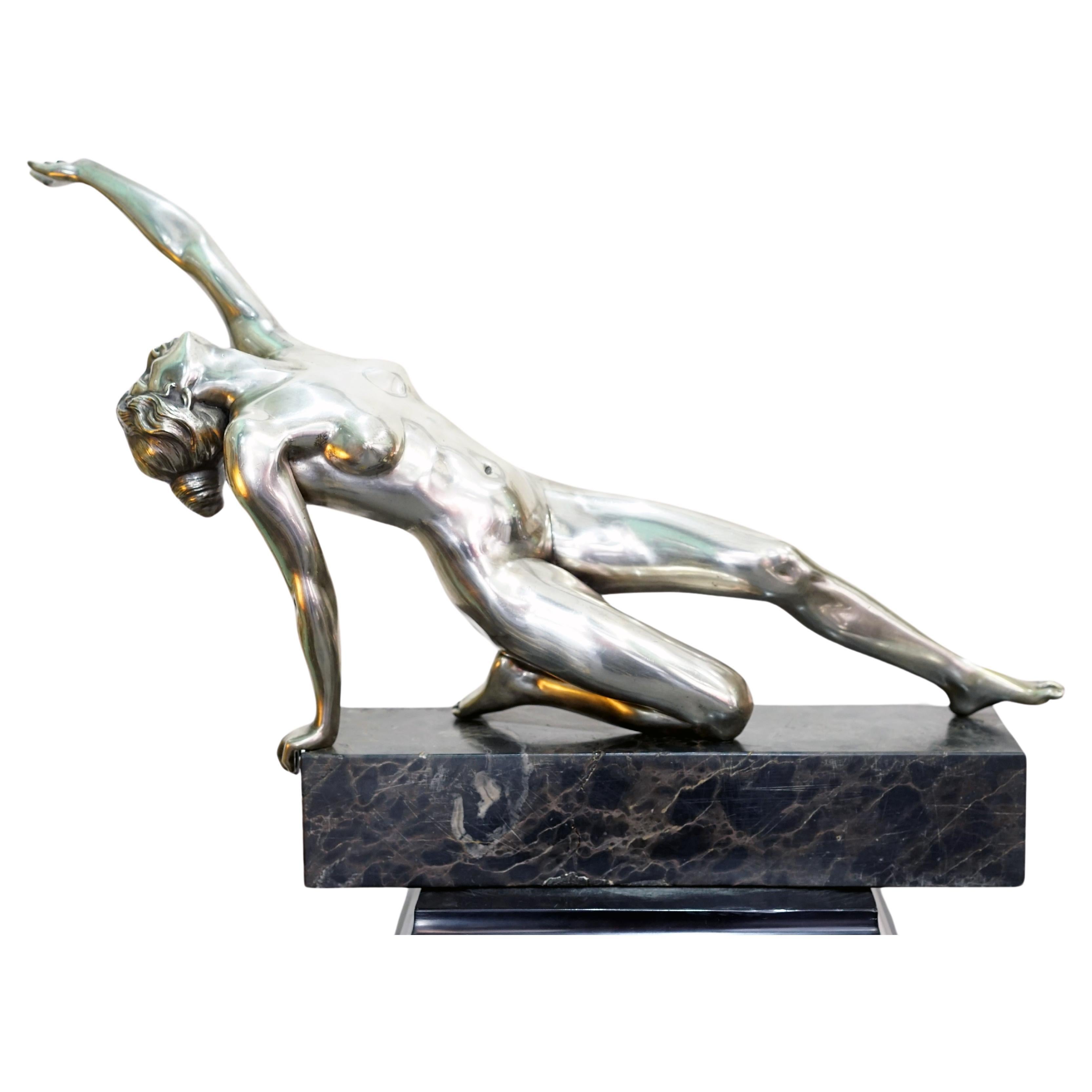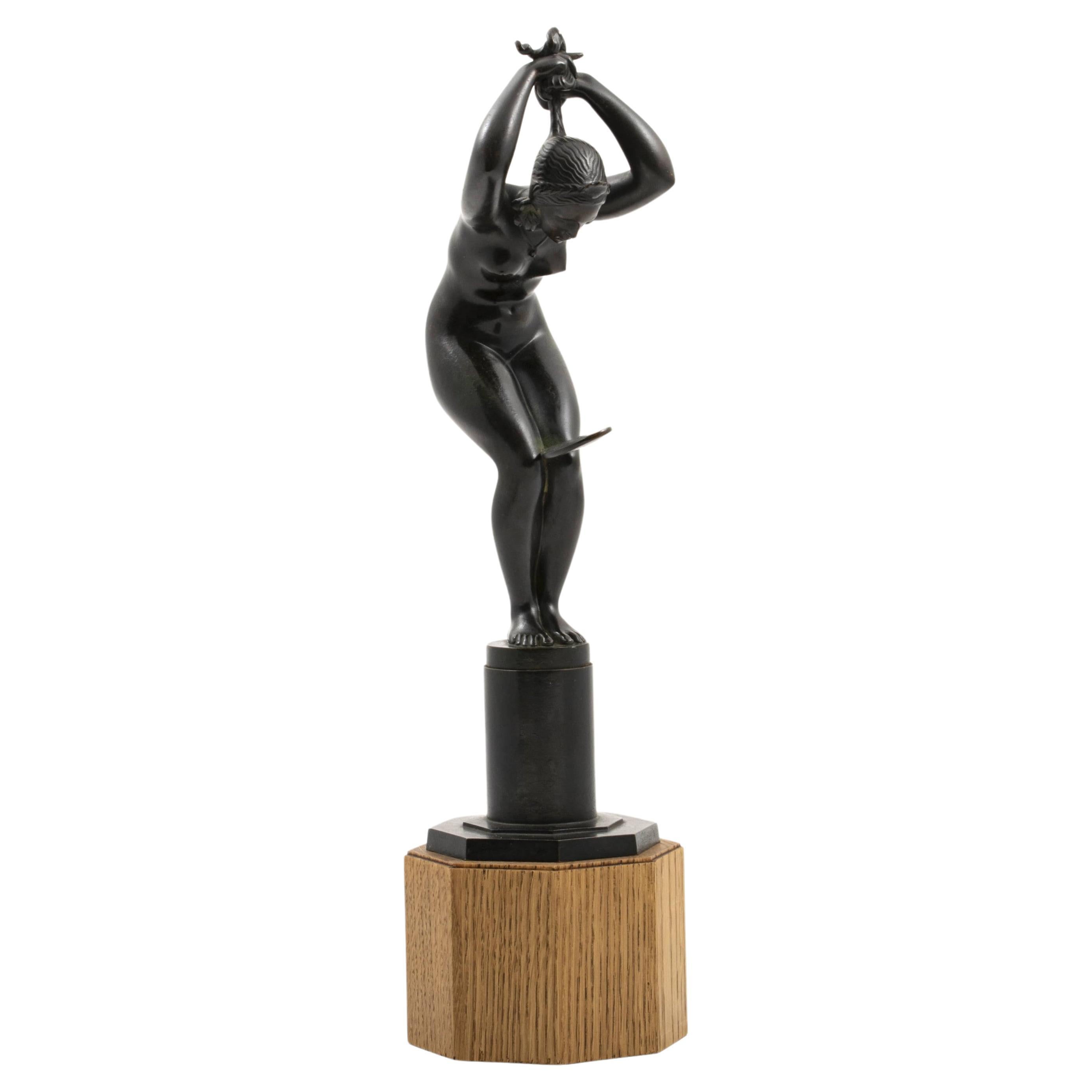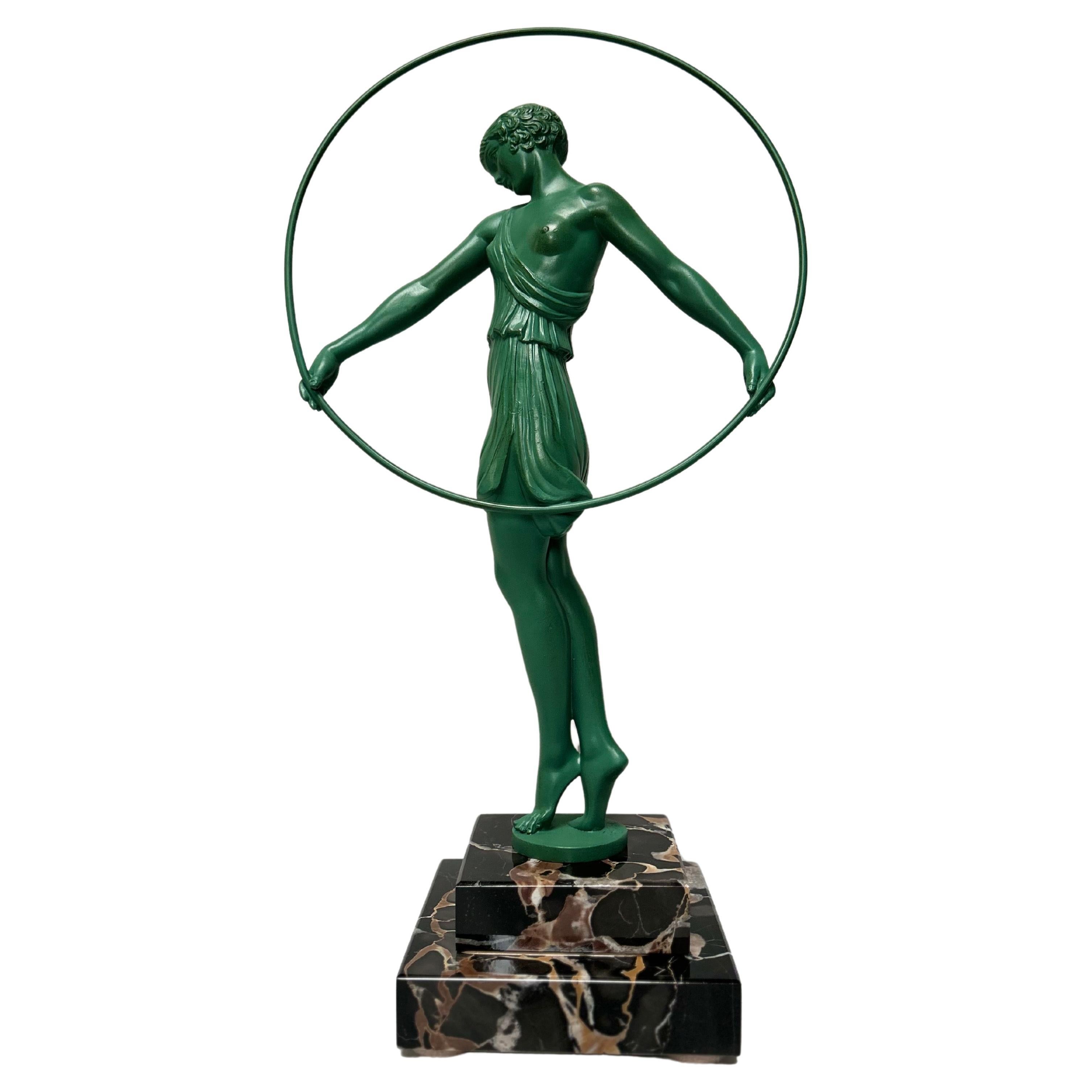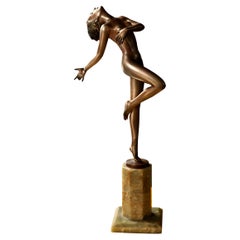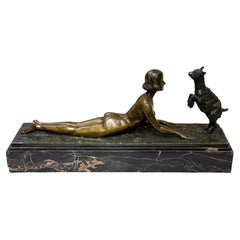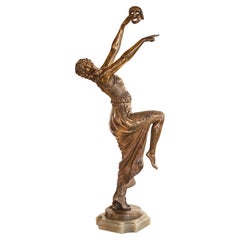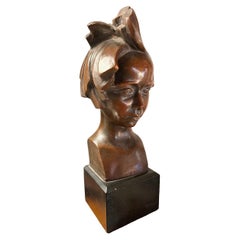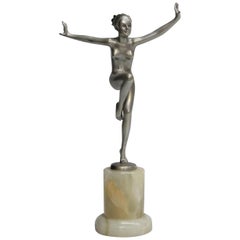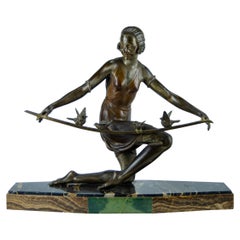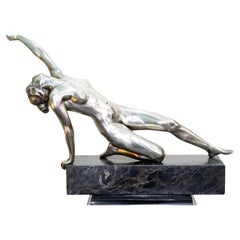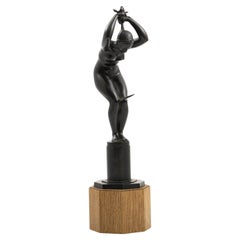Items Similar to Sculpture, 1920, Art Deco, Sign: Akl. Ges.H.Gladenbeck & Sohn
Video Loading
Want more images or videos?
Request additional images or videos from the seller
1 of 16
Sculpture, 1920, Art Deco, Sign: Akl. Ges.H.Gladenbeck & Sohn
$26,000
£19,634.16
€22,479.31
CA$36,718.80
A$40,088.14
CHF 21,016.57
MX$486,885.85
NOK 262,462.74
SEK 247,834.81
DKK 167,784.08
About the Item
Sign:
Aktien-Gesellschaft Gladenbeck was a foundry located in Berlin, Germany, that operated from 1851 until 1926. During the 75-year period when the foundry was in operation it was one of the most important foundries in Germany and was known for producing high quality bronze castings.
The Aktien-Gesellschaft Gladenbeck foundry opened for business in 1851 in Berlin, Germany, under the leadership of its founder, Carl Gustav Hermann Gladenbeck. It was one of the most important foundries in Germany, known for its high quality bronze castings.[1] Some of the first bronze sculptures that emerged from the foundry were marked "Gladenbeck" with subsequent castings over the years being marked "Gladenbeck und Sohn", "Akt-Ges v.H. Gladenbeck", "Akt-Ges Gladenbeck Berlin" or "Aktien-Gesellschaft Gladenbeck".
The foundry cast many of the best known bronze sculptures created by German artists in the mid-to-late 19th century and early 20th century. In addition to serving the usually modest casting requirements of German sculptors, the foundry was also capable of casting large-scale bronze statues. In 1913 the Gladenbeck foundry cast the monumental Confederate Memorial in Arlington National Cemetery.
In 1910, Gladenbeck cast theThree Dancing Maidens Untermyer fountain by sculptor Walter Schott. The fountain is located in Conservatory Garden, Central Park, New York. The sculpture – situated on a limestone plinth – depicts three young ladies holding hands in a circle "whose dresses cling to their wet bodies as if they were perpetually in the fountain's spray". The fountain includes three jets, two on the oval pool's sides and a larger one in the center of the sculpture.
In the early 1920s, art deco master Ferdinand Preiss employed Gladenbeck to cast many of his bronze and chryselephantine sculptures
We have specialized in the sale of Art Deco and Art Nouveau and Vintage styles since 1982. If you have any questions we are at your disposal.
Pushing the button that reads 'View All From Seller'. And you can see more objects to the style for sale.
Why are there so many antiques in Argentina?
In the 1880 – 1940 there was a grate wave of immigration encouraged by the periods of war that were taking place.
1st World War took place between 1914 and 1918
2nd World War took place between 1939 and 1945
The immigrants options were New York or Buenos Aires. Tickets were cheap and in Buenos Aires they were welcomed with open arms, as it was a country where everything was still to be done.
Argentina was the country of new opportunities, labour was needed and religious freedom was assured, in many cases the of the family travel first until they were settled and then the rest of the family members join them.
In the immigrant museum “Ellis Island Immigrant Building” in New York you can se the promotional posters of the boats that would take them to a new life.
Between the years 1895 and 1896, Argentina had the highest DGP (gross domestic product) per capita in the world according to the Maddison Historical Statistics index, this situation arose due to the large amount of food being exported to European countries, which were at war.
The Argentinean ships left the port of Buenos Aires with food, but they returned with furniture, clothes and construction elements, (it´s common to see this the old buildings of the historic neighbourhood of San Telmo, the beams with the inscription “Made in England)”, as well as many markets that were built in Buenos Aires, such us the San Telmo Market, whose structure was brought by ship and afterwards assembled in 900 Defensa Street.
With the great influence of European immigrants living in the country, the children of the upper classes travelled to study in France, resulting in the inauguration of “La Maison Argentinienne”, on 27th of June 1928, in the international city of Paris, which hosted many Argentinians that were studying in Frace.
It´s the fourth house to be built after France, Canada and Belgium, being the first Spanish-speaking one. Still in place today (17 Bd Jourdan, 75014, Paris, France). Many of the children of these wealthy families who attended international art exhibitions, museums and art courses abroad, took a keen interest in the European style. This is why Buenos Aires was at the time referred as “The Paris of South America”.
Between the years 1890 and 1920 more than a hundred Palaces were built on Alvear Avenue the most exclusive avenue in Buenos Aires. Today some of these palaces have been transformed into museums, hotels and embassies.
In the year 1936, the Kavanagh building was inaugurated, it was the tallest reinforced concrete building in South America.
During 1994 the American Society of Civil Engineers distinguished it as an “international engineering milestone”, and it´s now considered a World Heritage of Modern Architecture.
At the time was common to hire foreign architects such as Le Corbusier, who visited Buenos Aires/Argentina in 1929 and in 1948 he drew up the blueprints for a house built in La Plata City (which was declared a World Heritage Site).
In 1947, the Hungarian architect Marcelo Breuer designed “Parador Ariston” in the seaside city of Mar del Plata. After an Argentinean student at Harvard University convinced him to come to Argentina. He worked on an urban development project in the Casa Amarilla, area of La Boca.
The Ukrainian architect, Vladimiro Acosta, arrives in Argentina in 1928 and worked as an architect until que moved to Brazil.
Antonio Bonet, a Spanish architect who worked with Le Corbusier in Paris, arrives in Argentina in 1937, where he carried out several architectural works and in 1938 designs the well-known BFK chair.
Andres Kálnay, of Hungarian origin, made around 120 architectural masterpieces, among which the former Munich brewery stands out, he even made the furniture’s design.
The German architect, Walter Gropius, director of the Bauhaus, lived in Argentina, where he wrote articles for “Sur” magazine and founded in Buenos Aires, an architectural firm with Franz Möller, who was also an architect, where he built two houses.
At the same time several famous designers decided to immigrate to Argentina, among them we can find the well-known French designer, Jean-Michel Frank, who arrived in the country in 1940 and also worked for the Rockefeller family.
Special pieces were made, which were sold exclusively in the country, such as the well-known German company “WMF”, who sold their products by catalogue, which were chosen by the ladies of high society in the list of wedding gifts, as well as the pieces designed by Christofle.
The Swiss sculptor Alberto Giacometti, made special pieces for Argentinean mansions.
In 1904 the first Jansen branch outside Paris was established in Buenos Aires, as the Argentinean clientele demanded a large amount of furniture, from the end of the 19th century to the mid-20th century.
In 1970, the brand Rigolleau Argentina made pieces authorised by Lalique.
The brands Maple and Thompson also set up shop in the country.
The French plastic artist, Marcel Duchamp moved to Argentina in 1918-1919.
Glass signed Gallé, Charder, Leverre, Schneider, Muller and other French firms. They were bought in flower shops and were given to ladies with beautiful floral arrangements.
Some furniture manufacturers travelled to international fairs and bough the patterns to produce the furniture in Argentina, such as the furniture firm Englander and Bonta, who bought the patterns ins Italy.
It is worth mentioning that in Argentina we have the largest community of Italians outside of Italy, as it is estimated that 70 percent of the inhabitants have at least one Italian descendant, followed by Spanish immigrants.
The most Important furniture stores in Argentina:
Comte is founded in 1934 (under the direct management of Jean Michel Frank in 1940).
Nordiska (Swedish company established in 1934).
Churba in 1960, a company that brought foreign designers to present their furniture in the country:
Denmark: (Arne Jacobsen, Finn Juhl, Bender Madsen, Ejner Larsen, Poul Kjaerholm, Hans Wegner)
Sweden: (Hans Agne Jakobsson, Gustavsberg)
United States: (Herman Miller)
Finland: (Lisa Johansson, Folke Arstrom, Tapio Wirkkala, Alvar Aalto, Timo Sarpaneva)
Swedish Factory: (Orrefors)
Italy: (Littala, Vico Magistretti, Emma Gismondi, Gae Aulenti, Angelo Mangiarotti, Elio Martinelli, Gianna Celada, Angelo Mangiarotti, Mario Bellini, Carlo Scarpa)
Finland: (Olivia Toikka)
Plata Lappas (Lappas Silver): a goldsmith shop founded in 1887 in Argentina by Alcibiades Lappas of Greek origin.
In 2019, in Argentina took place “the Art Deco world congress”, in which we participated as hosts invited by Geo Darder, founder of the Copperbridge – Foundation, in which prominent people from all over the world attended to learn about Art Deco in Argentina.
Argentina currently has more than 100 Art Deco buildings and another 90 Art Nouveau buildings throughout the city of Buenos Aires.
Argentina is a country that has not been involved in many wars, which is why it has been a refuge for works of art and antiques from different periods of time, unlike European countries. That is way many collectors, museums and antique dealers from all over the world visit it, you should not miss the opportunity to visit this great country.
Laura Guevara Kjuder, architect.
- Dimensions:Height: 11.82 in (30 cm)Width: 3.55 in (9 cm)Depth: 3.55 in (9 cm)
- Style:Art Deco (Of the Period)
- Materials and Techniques:
- Place of Origin:
- Period:
- Date of Manufacture:1920
- Condition:Wear consistent with age and use.
- Seller Location:Ciudad Autónoma Buenos Aires, AR
- Reference Number:Seller: SC-441stDibs: LU6785234345502
About the Seller
5.0
Vetted Professional Seller
Every seller passes strict standards for authenticity and reliability
Established in 1982
1stDibs seller since 2022
40 sales on 1stDibs
Typical response time: <1 hour
- ShippingRetrieving quote...Shipping from: Ciudad Autónoma Buenos Aires, Argentina
- Return Policy
Authenticity Guarantee
In the unlikely event there’s an issue with an item’s authenticity, contact us within 1 year for a full refund. DetailsMoney-Back Guarantee
If your item is not as described, is damaged in transit, or does not arrive, contact us within 7 days for a full refund. Details24-Hour Cancellation
You have a 24-hour grace period in which to reconsider your purchase, with no questions asked.Vetted Professional Sellers
Our world-class sellers must adhere to strict standards for service and quality, maintaining the integrity of our listings.Price-Match Guarantee
If you find that a seller listed the same item for a lower price elsewhere, we’ll match it.Trusted Global Delivery
Our best-in-class carrier network provides specialized shipping options worldwide, including custom delivery.More From This Seller
View AllSculpture, 1920, Art Deco, Sign Lorenzl
Located in Ciudad Autónoma Buenos Aires, C
Sign:
Lorenz Josef
(Austria, 1892-1950). Sculptor, known for its dancers. Worked along with Goldscheider in Vienna.
Materials: Bronxe and onyx with the original patina
We have specialized in the sale of Art Deco and Art Nouveau and Vintage styles since 1982. If you have any questions we are at your disposal.
Pushing the button that reads 'View All From Seller'. And you can see more objects to the style for sale.
Josef Lorenzl (1 September 1892 – 15 August 1950) was an Austrian sculptor and ceramicist of the Art Deco period, the same era as Ferdinand Preiss (1882–1943) and Demetre Chiparus (1886–1947).
Lorenzl was born on 1 September 1882 in Vienna, Austria and died there on 15 August 1950. Little is known about his early years, but more is known about his later life. Lorenzl started his career working at a foundry at the Vienna Arsenal where he learned the techniques of bronze casting. The Vienna Arsenal was a military storage...
Category
Vintage 1920s Austrian Art Deco Figurative Sculptures
Materials
Onyx, Bronze
Joseph D´Aste Sculpture Italian, Art Deco Woman
By Joseph d' Aste
Located in Ciudad Autónoma Buenos Aires, C
Style: Art Deco
Material: marble and bronze
Country: Italy
We have specialized in the sale of Art Deco and Art Nouveau and Vintage styles since 1982. If you have any questions we are at your disposal.
Pushing the button that reads 'View All From Seller'. And you can see more objects to the style for sale.
Joseph D...
Category
Vintage 1920s Italian Art Deco Figurative Sculptures
Materials
Marble, Bronze
Woman, Art Deco, Design, Joe Descomps Cormier, France
By Joe Descomps Cormier
Located in Ciudad Autónoma Buenos Aires, C
Cormier Joseph Descomps
Born January 18, 1869, died on 24 April 1950. Joseph -Jules -Emmanuel Joseph Cormier becomes Descomps after World War II. Sculptor, engraver, master goldsmit...
Category
Vintage 1920s French Art Deco Figurative Sculptures
Materials
Marble, Bronze
Art Deco Boy Sculpture in Terracotta and Wood, Sign: C. Mulnis
Located in Ciudad Autónoma Buenos Aires, C
Style: Art Deco
Material: wood and terracotta
Country: london.
We have specialized in the sale of Art Deco and Art Nouveau and Vintage styles since 1982. If you have any questions we...
Category
Vintage 1920s English Art Deco Figurative Sculptures
Materials
Terracotta, Wood
Child sculpture in Bronze and marble
Located in Ciudad Autónoma Buenos Aires, C
Child sculpture in bronze and marble
Category
Vintage 1920s French Art Deco Figurative Sculptures
Materials
Marble, Bronze
Desing: Carlos de Lamota, Materials: Bronze and marble, Style : Art Deco
Located in Ciudad Autónoma Buenos Aires, C
Design: Carlos de Lamota
He was born on August 13, 1924, in the Province of San Juan, Argentina. His passion for art began at a very early age. At 11, he attended Anita Volspranky’s ...
Category
Vintage 1970s Argentine Mid-Century Modern Animal Sculptures
Materials
Marble, Bronze
You May Also Like
Josef Lorenzl Art Deco Sculpture, 1930s
By Josef Lorenzl
Located in Skanninge, SE
Josef Lorenzl Art Deco bronze sculpture.
Size: Height 33cm.
The cold painted bronze sculpture is mounted on a Brazilian green onyx plinth.
All in an o...
Category
Vintage 1930s Austrian Art Deco Figurative Sculptures
Materials
Bronze
Art Deco Sculpture Author G. Arisse
By G. Arisse
Located in Buenos Aires, Argentina
Art Deco sculpture author G. Arisse
Origin France Circa 1930
Materials: white metal (patinated)
Very good conditions
Natural wear.
Category
Vintage 1930s French Art Deco Figurative Sculptures
Materials
Pewter
$2,240 Sale Price
20% Off
Franz Peleschka Art deco bronze
By Franz Peleschka 1
Located in Buenos Aires, Argentina
Franz Peleschka bronze sculpture
Origin Austria Circa 1900
The condition of the bronzes is excellent, its base has been restored by a professional.
Patina raised
It is signed on its ...
Category
Antique Early 1900s Austrian Art Nouveau Figurative Sculptures
Materials
Marble, Bronze
Jens Jakob Bregnø Art Deco Bronze Sculpture, circa 1930s
Located in Kastrup, DK
Jens Jacob Bregnø (1877-1946).
A dark patinated bronze sculpture of a nude woman braiding her hair while holding a mirror between her knees.
Signed with monogram to the base JJB.
On ...
Category
Vintage 1930s Danish Art Deco Figurative Sculptures
Materials
Bronze
Max Le Verrier Art Deco Sculpture by Le Faguays
By Pierre Le Faguays
Located in NANTES, FR
Large model of art deco sculpture "Danseuse aux cerceaux" pati. Subject in spelter with green patina on black marble base, signed on the base.
Model by Le Faguays published by Max Le...
Category
Mid-20th Century French Art Deco Figurative Sculptures
Materials
Marble, Spelter
Art Deco Sculpture Signed Carlier
By Émile Nestor Joseph Carlier 1
Located in NANTES, FR
Large art deco illuminating sculpture, circa 1930.
Spelter sculpture on marble base.
Opalescent glass ball soap bubble.
In perfect condition and electrified
Length: 17,5 cm
Diam...
Category
Mid-20th Century French Art Deco Figurative Sculptures
Materials
Marble, Spelter
More Ways To Browse
Preiss Ferdinand
Gladenbeck Bronze
Limestone Plinth
Walter Schott
Glazed Ceramic Pumpkin
Hand Painted Chinese Porcelain Figurines
Inuit Sculptures
Lladro Figurines Used
Marble Base Statue
Pagoda Sculpture
Painted Mannequin
Polychrome Wood Statue
Roman Fragment
Rosario Vintage
Sculpture Of Michelangelo
Snake Charmer
Spanish Furniture 15th Century
19th Century Diana Sculpture
